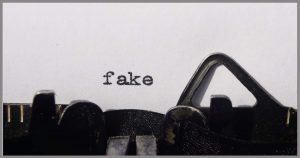Spam is often in the eye of the recipient

I’ve been wrongly labeled as a spammer – what can I do about it?
I have used the same email address (me@mydomain.co.uk) for about 10 years. I am the author of a newsletter which goes to about 150 people, ALL of whom have ASKED to be included in my list, and I send and receive about 30 emails/day, mainly business. I never have and do not currently use my ID for any spamming to anyone, nor do I forward any of the dozens of spam emails I receive from “friends.”
When I sent an email to two different local contacts recently, I received the same message by return: “This message was undeliverable due to the following reason: Your message was not delivered because the return address was refused. The return address was “<me@mydomain.co.uk>” Please reply to <Postmaster@ispmail.ntl.com> if you feel this message to be in error.”
I DO consider this message to be SERIOUSLY in error – I have written to them several times, but I have been ignored. What do I do now, please?
Very little you haven’t already done.
You’re assuming the message means the remote system thinks you’re a spammer. While I suspect it’s likely, it’s not always true.
Even if it is, it’s important to realize this isn’t some global database where everyone in the world now thinks you’re a spammer.
On the contrary. It’s very likely to be this one email system you’re having trouble with and perhaps even only a single user thereon.
Become a Patron of Ask Leo! and go ad-free!

Accused of being a spammer?
Email bounces marked as undeliverable could imply many issues, not necessarily spamming. The refusal of your return address could be a result of address blocks, DNS issues, or a configuration error on the recipient’s server. There’s little to be done, other than making sure you’re following best “I’m not sending spam” practices. Consider using an email service for mass mailings instead of your own personal account.
“Return address was refused”
One of the frustrations of diagnosing email errors in general is ambiguity.
This error could mean so many things.
It could mean the user you’re sending to actively blocked your email address from sending to them. Depending on the service, this could be entirely separate from spam processing.
It could mean that the mail server was unable to validate your email address.Perhaps the DNS servers resolving “mydomain.co.uk” or the mail records associated with it were having a problem. Again, this is unrelated to spam.
It could mean a configuration error on the part of the recipient’s email server. Particularly for smaller services, this is surprisingly easy to have happen.
And, of course, it could mean the system has identified your email address as a source of spam.
It still might not be you.
My assumption
Before I go further though, I have to be clear about something: I’m assuming you’ve actually not been sending spam.
That means:
- All your recipients asked to be sent your email. Adding recipients to a list without their permission is spamming.
- Your email delivers what was promised at the time the recipients agree to get it. If you start out with a newsletter about one thing, but then transition it to something else unrelated, many recipients consider that spam.
You said you’re not spamming, and I believe you. But if somehow you are — even accidentally — that could be the root of the problem.
Spam versus spam
Let’s assume for a moment the email is being rejected because your email address has been listed as being source of spam.
It’s possible the people that you’re sending messages to have clicked the “This is spam” button. It happens all too often on legitimate non-spam — either because the button is too close to the Delete button, you’ve said something to annoy the recipient, or perhaps they’re just too lazy to look for your unsubscribe link.
You email address could still get marked as a source of spam.
It’s extremely common for spam to be sent “From:” spoofed email addresses. This means a spammer could be sending spam looking like it’s “From:” you, even though you’re not involved in any way. The recipients of those messages could legitimately hit the “This is Spam” button.
This is so common, most spam filters should be ignoring the “From:” line. They’re random these days and have little to do with the source of the message.
However, some may still do so; as a result, you, an innocent bystander, pay the price.
About “postmaster”
The email address “postmaster@” is supposed to be valid for every domain capable of sending or receiving email. Most email servers will come pre-configured with error messages suggesting you contact that email address for additional assistance.
In practice it rarely helps.
- Because it’s predefined, the “postmaster” email address probably gets more spam than any other email address.
- Because there’s so much spam and so many spam-related issues, the person(s) handling email sent to postmaster are very likely overwhelmed.
- The email address is often ignored completely.
That’s not to say that all email servers handle postmaster poorly, but many do. The work associated with responding properly is just too overwhelming.
One way you could legitimately be at risk
There is one aspect of your description that concerns me, and could indeed cause email services to be more likely to consider you a spammer.
If you’re sending:
- A single message
- To 150 people at once
- From a personal email account
That, at best, is suspicious. It’s often what spammers do when they hijack an account. As a result, while by itself it may not cause you to be labelled a spammer, it’s a signal that spam filters often use to increase the odds of doing so.
Instead of sending directly from your own email account, consider using discussion groups like groups.io, or Google Groups, or others, or mailing list services such as Aweber, MailChimp, and others, to send email on your behalf. This is their job, and they are configured specifically to reduce the odds of your email being labelled spam.
Do this
There’s surprisingly little to be done about the situation you describe.
Focus on following best practices to not be perceived as a spammer, and consider having some kind of service send that large volume of email on your behalf.
No spam here! Subscribe to Confident Computing! Less frustration and more confidence, solutions, answers, and tips in your inbox every week.


Using a specific email address that’s different from your normal one to send newsletters, etc. is a good idea too. It may reduce the chances your primary account will be tagged as a spammer.
I also post a newsletter to about 60 addresses in the UK.THe BT (British Telecom) Postmaster used to reject my mail “as it may be spam”. This was purely because about 8 of my recipients were BT clients. Solution: I split my list and put half on each one.
I have gotten that message when the email is no longer valid (they’ve deleted thier email acct)
I’ve encountered that problem, and following up on it, I found that my domain was being blacklisted for the SOLE reason that it COULD be used for spam, whether or not any actual complaints or reports had occurred. It’s been less of a problem in the last couple years, but still not eliminated. Of course, I can eliminate the problem by PAYING to have it whitelisted.
I get the spam message when I send to elected officials who have been replaced. I have to call to ask the new person to add my e-address to their contacts.
I used the above email to show ‘racsa’ address. (avefenix@racsa.co.cr)This is a government monopoly ISP for dialup in Costa Rica. Therefore there are perhaps hundreds of thousands of users (I have no idea), but any spam that comes out of that address and gets to verison or comcast will shut down all traffic to them from any one of us. Just a comment. It usually gets going again shortly and I have a lot of other addresses, but many do not.
Fred Christman
Let me comment a bit further. I personally have quite a few domains with Verio. These are small and shared with other users in various ways by Verio on a single computer and sometimes on a single IP. The same thing happens there when it’s NOT the same domain.
I’ve also had issues like this because I’m on a Shared Hosting server where I share the same IP address with several if not many other websites. All it takes is for one rogue account with an outdated and insecure script running on it for hackers to set it up as a spam bot. Of course this gets noticed and removed by the hosting providers but not before thousands of spam emails have been sent out. The server’s IP address usually gets blacklisted for at least 24 hours.